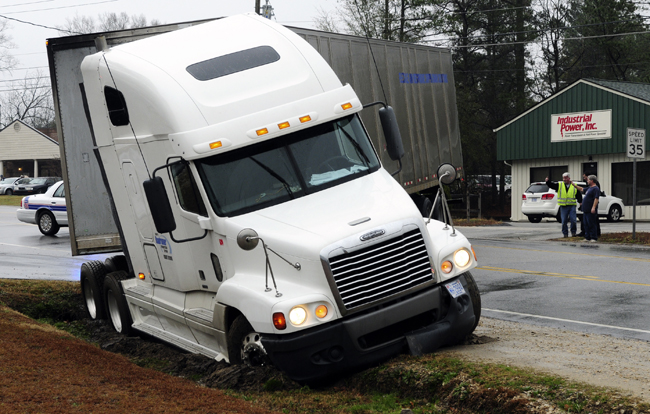Don’t Let Your Load Block the Road
That should be the mantra of anyone (whether 18-wheeler driver or not) trailering cargo on our highways. I picked up that saying from a recent discussion at a lawyers’ conference about tractor-trailers making u-turns or other types of turns which block intersections, divided highways, and lanes of travel.

This semi truck is blocking a section of Whitfield Road after it was stuck in the mud on the side of the road at 12:30 pm on Wednesday afternnoon, Jan 11, 2012.
Staff photo by Marcus Castro
Making a u-turn, or any turn across multiple lanes, while pulling a trailer is just not as simple as making the same manuever in a car or light truck. For most full-sized tractor trailers, it takes the equivalent of five lanes of traffic to perform a u-turn. Such a turn is simply not possible in most parts of Alabama without blocking the oncoming lanes of travel for a significant period of time.
Consider this: It takes a car traveling 55 mph 10 seconds to travel 800-1000 feet. In 30 seconds, that same car travels 2400-3000 feet, more than half a mile. Therefore, what may seem like a situation where the “coast is clear” for a u-turn or other time-consuming turn can quickly change. The same thing goes when a vehicle pulling a trailer must cross a highway at an intersection. If the trailer is blocking the road, especially at night or in low-visibility situations, it presents a serious danger. Cars can “underride” trailers, which is one of the most dangerous crash scenarios on the road.
Another issue which can cause a collision is what as known as low or no “conspicuity,” otherwise known as the ability to been seen or noticed. Federal regulations require that certain vehicles and trailers have lights, reflective tape, etc. so that they may be seen in low or no-light situations. Sometimes, these preventive measures do not function, either because they are not working properly or are covered up with mud, grease, etc. On other occasions, they may not be effective because they can’t be seen due to the angle of the approaching vehicle or the existence of other lights in the area. Simply put, a person pulling a trailer cannot rely on these devices to prevent a collision. The best way to avoid such a collision is to avoid blocking the road in a dangerous manner.
Thousands of individuals are injured in collisions with trailers (both commercial and personal) in the United States every year. If pulling a trailer, take special care to prevent these collisions by considering how your turn might effect other drivers.


